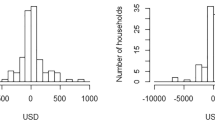Abstract
To augment the incomes of smallholder farmers in Kenya and consequently improve their nutrition and income, many development organisations and policy makers are increasingly promoting dairy goat farming. Among the key organisations supporting the initiative is Heifer Project International—Kenya (HPIK). However, the economic contribution and viability of dairy goats under the HPIK project have not been studied so far. The aim of the present study was to determine the contribution of dairy goats to household income and the performance of the dairy goat enterprise using gross and net margins from dairy goat farming as an indicator of economic viability. A survey covering 71 farmers was carried out in the Coast, Nyanza, and the Rift Valley provinces of Kenya using a set of pre-tested structured and semi-structured questionnaires. Results showed that, on average, the dairy goat enterprise contributed, correspondingly, about 15.2% and 4.8% to the total livestock and overall household income and was viable. Differences in gross and net margins across agroecological zones were attributed to milk prices. Despite the existence of non-viable enterprises in two of the provinces, the few present suggest the possibility of obtaining reliable incomes from the enterprise. Redoubling of effort or re-orientation of production to match the local and external requirements would, however, be necessary. Costs and revenues were similar across the agroecological zones. Farmers with positive gross margins had better milk and stock sales and vice versa. The success of a dairy goat enterprise is attributed to location and good management. Besides, farmers’ awareness of the market demands within and outside the community is important in establishing production goals and may be crucial to achieving a positive gross margin.
Similar content being viewed by others
References
Ahuya, C.O., Okeyo, A.M., Mwangi-Njuru, Peacock, C., 2005. Developmental challenges and opportunities in the goat industry: The Kenyan experience. Small Ruminant Research, 60, 197–206.
Alam, M.R., 2000. Goat raising in the smallholder farming systems in Bangladesh. In: Proceedings of the Seventh International Conference on Goats, 15–21 May, 2000, Tours, France, pp. 329–330.
Ayalew, W., Rischkowsky, B., King, J.M., Bruns, E., 2002. Crossbreds did not generate more benefits than indigenous goats in Ethiopian smallholdings. Agricultural Systems, 76, 1137–1156.
Gürsoy, O., 2006. Economics and profitability of sheep and goat production in Turkey under new support regimes and market conditions. Small Ruminant Research, 62, 181–191.
Haenlein, G.F.W., 2002. Goat Management. Alternatives in Dairy Goat Product Market. http://www.goatworld.com/articles/goatmanagement.shtml; Accessed on 16th March, 2007.
Johnson, D.T., 1990. The Business of Farming: A Guide to Farm Business Management in the Tropics. Second edition, Macmillan, London and Basingstoke, 377 pp.
Kosgey, I.S., Baker, R.L., Udo, H.M.J., van Arendonk, J.A.M., 2006. Successes and failures of small ruminant breeding programmes in the tropics: a review. Small Ruminant Research, 61, 13–28.
Kumar, S., Deoghare, P.R., 2000. Goat rearing and rural poor: a case study from India. In: Proceedings of the Seventh International Conference on Goats, 15–21 May 2000, Tours, France, pp. 554–556.
Mwandotto, B.A.J., Wachira, J.D., Chemitei, V.C., 1992. Small ruminant research in Kenya. In: Rey, B., Lebbie, S.H.B., Reynolds, L. (eds.), Small ruminant research and development, Proceedings of the First Biennial Conference of the African Small Ruminant Research Network ILRAD, 10–14 December 1990, Nairobi, Kenya. www.fao.org/wairdocs/ilri/x5520b/x5520b04.htm#small ruminant research in Kenya; Accessed on 4th February, 2007.
Németh, T., Branduse, L., Ábrahám, M., Kukovics, S., 2004. Factors affecting the profitability of different goat farm sizes in Hungary. South African Journal of Animal Science, 34, 126–129.
Ogola, T.D.O., Nguyo, W.K., Kosgey, I.S. 2009. Dairy goat production practices in Kenya: implications for a breeding programme. Livestock Research for Rural Development (in press).
Panin, A., Mahabile, M., 1997. Profitability and household income contribution of small ruminants to small-scale farmers in Botswana. Small Ruminant Research, 25, 9–15.
Rewe, T.O., Ogore, P.B., Kahi, A.K., 2002. Integrated goat project in Kenya: impact on genetic improvement. In: Proceedings of the Seventh World Congress on Genetics Applied to Livestock Production, vol. 33, 19–23 August, 2002, Montpellier, France, pp. 385–387.
Shirima, E.J.M., 2005. Benefits from dual purpose goats for crop and livestock production under small-scale peasant systems in Kondoa eroded areas, Tanzania. Livestock Research for Rural Development, 17(12), http://www.lrrd.org/lrrd17/12/shir17138.htm; Accessed on 12th July, 2009.
Staal, S.J., 2002. The competitiveness of smallholder dairy production: evidence from sub-Saharan Africa, Asia and Latin America. In: Rangnekar, D., Thorpe, W. (eds.), Smallholder dairy production and marketing—opportunities and constraints, Proceedings of a South–South Workshop held at NDDB, Anand, India, 13–16 March, 2001. NDDB (National Dairy Development Board), Anand, 538 pp.
Tadele, T., 2007. Improving women farmers’ welfare through a goat credit project and its implications for promoting food security and rural livelihoods. Journal of Rural and Community Development, 2, 123–129
Acknowledgements
We are grateful to Heifer Project International—Kenya and the Higher Education Loans Board (Ministry of Education, Science and Technology, Nairobi, Kenya) for financial support to the first author. We thank Egerton University (Njoro, Kenya) for provision of facilities and support for the study. The Ministry of Livestock Development is humbly appreciated for granting the first author study leave during this study. Thanks to the farmers who participated in the project.
Author information
Authors and Affiliations
Corresponding author
Rights and permissions
About this article
Cite this article
Ogola, T.D.O., Nguyo, W.K. & Kosgey, I.S. Economic contribution and viability of dairy goats: implications for a breeding programme. Trop Anim Health Prod 42, 875–885 (2010). https://doi.org/10.1007/s11250-009-9501-x
Accepted:
Published:
Issue Date:
DOI: https://doi.org/10.1007/s11250-009-9501-x




